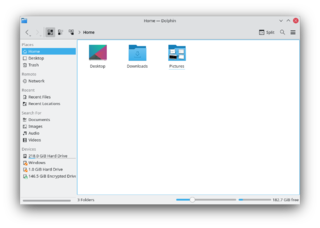Dolphin/ja: Difference between revisions
Appearance
No edit summary |
Updating to match new version of source page |
||
| (29 intermediate revisions by 3 users not shown) | |||
| Line 2: | Line 2: | ||
{|class="vertical-centered" | {|class="vertical-centered" | ||
|[[ | |[[File:Dolphin.png|thumb|center|320px]]|| ||'''使いやすさに注力した、必要な機能の揃ったファイル管理ソフトウェア''' | ||
|} | |} | ||
<span id="Feature_Overview"></span> | |||
==特徴の概要== | ==特徴の概要== | ||
:* | Dolphinは軽量なファイルマネージャーです。使いやすさとシンプルさを念頭に置いて設計されていますが、柔軟なカスタマイズも可能です。つまり、自分の思い通りにファイル管理を行うことができます。Dolphinの扱い方については、この[[Special:myLanguage/Dolphin/File Management | チュートリアル]] や[http://docs.kde.org/stable/en/applications/dolphin/index.html ハンドブック]に詳しい情報があります。 | ||
<div class="mw-translate-fuzzy"> | |||
:* 必要な機能の揃った、簡単に使えるファイル管理ソフトウェアです | |||
:* 使いやすさに注力しています | :* 使いやすさに注力しています | ||
:* ''パンくずリスト''を採用したナビゲーションバー | :* ''パンくずリスト''を採用したナビゲーションバー | ||
| Line 12: | Line 16: | ||
:* [[Special:myLanguage/Glossary#KIO|KIO]]を介して、他のコンピュータや擬似ファイルシステム上のファイル管理も行えます | :* [[Special:myLanguage/Glossary#KIO|KIO]]を介して、他のコンピュータや擬似ファイルシステム上のファイル管理も行えます | ||
:* [[Special:myLanguage/Glossary#Nepomuk|Nepomuk]]を使い、ファイルやフォルダにタグ付けしたり、ファイルの内容を対象に検索することができます | :* [[Special:myLanguage/Glossary#Nepomuk|Nepomuk]]を使い、ファイルやフォルダにタグ付けしたり、ファイルの内容を対象に検索することができます | ||
</div> | |||
一見シンプルなファイル管理ソフトウェアに見えますが、実は色々な機能があるのです。以下のようなものなどがあります。 | 一見シンプルなファイル管理ソフトウェアに見えますが、実は色々な機能があるのです。以下のようなものなどがあります。 | ||
| Line 26: | Line 31: | ||
:* 多くの機能がキーボードショートカットで操作できます | :* 多くの機能がキーボードショートカットで操作できます | ||
<span id="Tutorials"></span> | |||
== チュートリアル == | == チュートリアル == | ||
:* [[Special:myLanguage/Dolphin/File Management#Discover Dolphin|Discover Dolphin]] | :* [[Special:myLanguage/Dolphin/File Management#Discover Dolphin|Discover Dolphin]] | ||
:* [[Special:myLanguage/Dolphin/File_Management#Archive_Management_in_Dolphin|Archive Management in Dolphin]] | :* [[Special:myLanguage/Dolphin/File_Management#Archive_Management_in_Dolphin|Archive Management in Dolphin]] | ||
:* [[Special:myLanguage/Dolphin/Customize Folder Icon|Customize the icon of a folder]] | :* [[Special:myLanguage/Dolphin/Customize Folder Icon|Customize the icon of a folder]] | ||
:* [[Special:myLanguage/Dolphin/Batch_Rename|Rename multiple files at the same time]] | :* [[Special:myLanguage/Dolphin/Batch_Rename|Rename multiple files at the same time]] | ||
== | <span id="Hints,_Tips_and_Troubleshooting"></span> | ||
== ヒントとトラブルシューティング == | |||
''' | '''Problem:''' When I choose the application to open a specific filetype with, it seems to affect other filetypes too. It’s like '''Dolphin''' cannot tell the difference between the ''two different filetypes''. | ||
:'''Solution:''' Probably the KDE platform does not know about one of the two filetypes, so it associates the filetype to a different, known filetype. This is common with XML-based filetypes; even if they use a file extension of their own (e.g. <tt>.xliff</tt> or <tt>.graphml</tt>), if they are not a filetype known by the KDE platform, they will be treated as any other XML file, and opened with the default application to open XML files. | |||
:To solve this issue, you can use [[Special:myLanguage/System Settings/File Associations|File Associations]] to [[Special:myLanguage/System Settings/File Associations#Adding new file types|create an entry for the unrecognized filetype]]. | |||
'''Problem:''' Dolphin's Find File service doesn't find files you know are on your computer. | |||
:'''Solution:''' Reindex [[Special:myLanguage/Baloo|Baloo]]. Baloo is a file indexing and search service that Dolphin uses to search for files. It needs to be indexed to work. To solve this problem, in a terminal type, <tt>balooctl check</tt> | |||
'''Problem:''' | '''Problem:''' There is no file transfer dialog. | ||
:'''Solution:''' | :'''Solution:''' As of KDE 5 jobs like file transfers are handled by default in centralized notification system; file transfer is also shown in task manager. To enable separate file transfer dialog disable file transfer tracking on both the System Tray notification area and the task manager plasmoid and re-login. | ||
<div class="mw-translate-fuzzy"> | |||
あなたの問題がこのリストにない場合は、[http://forum.kde.org/viewforum.php?f=222 フォーラム]を調べたり、そこで質問することもできます。 | |||
</div> | |||
<span id="Keywords"></span> | |||
== キーワード == | == キーワード == | ||
<div class="mw-translate-fuzzy"> | |||
ファイル管理, ファイル マネージャー, ファイル ブラウザー, メタデータ, Nepomuk | ファイル管理, ファイル マネージャー, ファイル ブラウザー, メタデータ, Nepomuk | ||
</div> | |||
[[Category:Dolphin/ja]] | [[Category:Dolphin/ja]] | ||
Latest revision as of 03:55, 19 May 2024
 |
使いやすさに注力した、必要な機能の揃ったファイル管理ソフトウェア |
特徴の概要
Dolphinは軽量なファイルマネージャーです。使いやすさとシンプルさを念頭に置いて設計されていますが、柔軟なカスタマイズも可能です。つまり、自分の思い通りにファイル管理を行うことができます。Dolphinの扱い方については、この チュートリアル やハンドブックに詳しい情報があります。
一見シンプルなファイル管理ソフトウェアに見えますが、実は色々な機能があるのです。以下のようなものなどがあります。
- 分割ウインドウ - 2つのディレクトリを同時に開くことができます
- 表示オプションはウインドウ毎に設定、保存できます
- タブブラウジング
- 右側に情報パネルを表示できます
- あるいはウインドウ内に必要な情報を表示することもできます
- 'パンくずリスト'でナビゲーションを効率化できます
- 1クリックでナビゲーションバーにパスを入力できます
- 伝統的なナビゲーション方法の使えるフォルダーパネルを追加できます
- 今開いているディレクトリで作業できるターミナルをウインドウに追加できます
- 多くの機能がキーボードショートカットで操作できます
チュートリアル
ヒントとトラブルシューティング
Problem: When I choose the application to open a specific filetype with, it seems to affect other filetypes too. It’s like Dolphin cannot tell the difference between the two different filetypes.
- Solution: Probably the KDE platform does not know about one of the two filetypes, so it associates the filetype to a different, known filetype. This is common with XML-based filetypes; even if they use a file extension of their own (e.g. .xliff or .graphml), if they are not a filetype known by the KDE platform, they will be treated as any other XML file, and opened with the default application to open XML files.
- To solve this issue, you can use File Associations to create an entry for the unrecognized filetype.
Problem: Dolphin's Find File service doesn't find files you know are on your computer.
- Solution: Reindex Baloo. Baloo is a file indexing and search service that Dolphin uses to search for files. It needs to be indexed to work. To solve this problem, in a terminal type, balooctl check
Problem: There is no file transfer dialog.
- Solution: As of KDE 5 jobs like file transfers are handled by default in centralized notification system; file transfer is also shown in task manager. To enable separate file transfer dialog disable file transfer tracking on both the System Tray notification area and the task manager plasmoid and re-login.
あなたの問題がこのリストにない場合は、フォーラムを調べたり、そこで質問することもできます。
キーワード
ファイル管理, ファイル マネージャー, ファイル ブラウザー, メタデータ, Nepomuk
